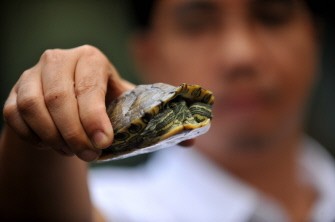MANILA, March 9, 2011 (AFP) - Like some bad science-fiction movie, Philippine fishermen are encountering strange alien creatures: tough, speckled fish with sharp spines that tear and rip their nets.
These suckermouth catfish from South America are just one of a growing number of foreign species that are spreading in local waterways and forests, threatening to edge out the country's indigenous plants and animals.
The catfish, locally known as "janitor fish", were originally introduced locally for aquariums but careless handling and weak controls allowed them to escape into the wild -- just like scores of other animals and plants.
These foreign species may look like cute turtles or lovely flowers but government wildlife experts warn that they are displacing native plants and animals while causing massive harm to the farming and fishing industries.

"The ecological threat of invasive species is so great, they could transform the landscape, wipe out native species and destroy the diversity of the ecosystem," said government wildlife specialist Anson Tagtag.
In the case of the suckermouth catfish, it has multiplied faster than local species while competing with them for food and building nests in mud banks, dirtying the waters.
Filipinos generally find janitor fish unpalatable so those that are caught by fishermen go to waste.
In a belated response to threat posed by all foreign species, the government has just begun a three-year programme to find out exactly what is out there and devise strategies to contain or eradicate the problems.
The programme is not expected to work miracles but it is a promising start after decades of foreign plants and animals being brought into the country without enough safeguards.
Tagtag, who is one of the leaders of the programme, said there were about 100 alien plant and animal species known to have become a problem in the Philippines.
Many of these invaders were welcomed into the country, initially for their supposed beneficial effects or as ornamental plants or pets, he said.
Perhaps the best -- or worst -- example was the Taiwanese golden apple snail, introduced by the government in the 1970s as a possible alternative food source for farmers, he said.
Filipinos never developed a taste for the golden snail but the snail's taste for rice crops now causes millions of dollars in agricultural damage every year, Tagtag told AFP.
Other invaders, such as the water hyacinth, were brought into the country purely to decorate fishponds.
Now this floating water plant reproduces wildly, clogging water systems and preventing sunlight from reaching other aquatic vegetation.
Tagtag said that in the past there was a lack of clear rules that made it easy to bring in potentially harmful species such as American bullfrogs or the climbing "santana" vines that have flourished.
The Philippines, like its neighbours in Southeast Asia, is generally behind European countries in imposing controls on these alien species, according to Tagtag.
"We are all in the same stage. We all similarly realised just recently how serious this problem is," he said.
Some Southeast Asian countries, such as Thailand and Vietnam, have launched programmes to eradicate foreign species but the Philippines merely has poorly enforced regulations to control their entry, Tagtag said.
The danger of more such alien invaders entering the country is evident at the country's shopping malls where exotic animals are peddled in select pet stores.
"Most pet owners are not responsible owners. They tend to throw away animals when they are no longer interested, (allowing them to reproduce in the wild)," said Josefina de Leon, chief of the government's wildlife resources division.
At one pet store in Manila, huge, sharp-toothed alligator gars -- a fish that looks like an alligator -- swim inside large aquariums while pinkish African frogs hop about in a giant glass jar.
"We have to look into that. I don't know if we have authorised breeders of alligator gars," said de Leon when asked about the legality of selling the exotic North American species.
Shady pet stores are often raided and their alien species seized but they inevitably reopen with new exotic animals for sale.
"From time to time, we conduct raids of pet stores, we have charged many people and filed many cases. But we have too few people to do the job," said Primo Capistrano, head of the environment agency's regional wildlife division.
"No matter how many times you raid them, they come back."
On a national scale, with 122 small ports and 35 major piers, government agencies simply do not have the manpower and resources to prevent these alien species from being smuggled in, according to de Leon.
The environment department's programme aims to understand the scope of the invasion of alien species and formulate policies to deal with them, be it containment, control or eradication.
De Leon said they already knew that toxic weeds now contaminated the country's pasture lands, while local frogs were being over-run by invaders from North America and Taiwan.
There are also unverified reports of Chinese soft-shelled turtles being found southeast of Manila and persistent rumours that flesh-eating piranhas have been smuggled into the country.
But while there is much hope for the new campaign, De Leon warned it would fail unless the environment department had much broader support than it currently received.
"There are people who do not want to cooperate. This is not just an issue of enforcement. We have to educate the local governments, senators, the judiciary," she said.
























